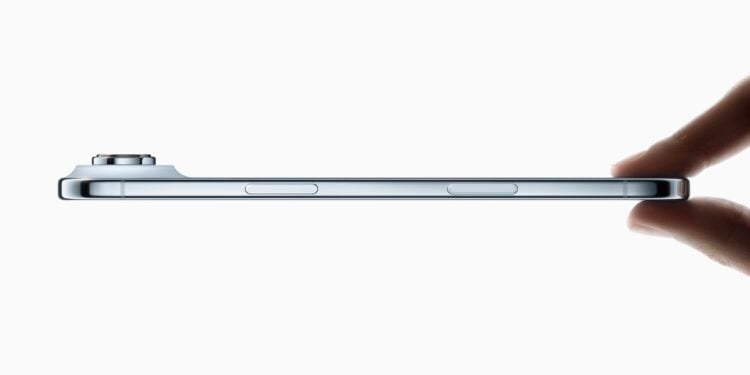The iPhone Air marks a new milestone in Apple's smartphone history. At just 5.6 millimeters thick, it's the thinnest iPhone ever built. At the same time, it's said to be more robust than any previous model. Apple not only tested the device under lab conditions, but also threw, bent, and subjected it to abuse in interviews and live situations before its launch. The message is clear: Thin doesn't mean fragile.
On September 9, 2025, Apple unveiled the iPhone Air during its "Awe Dropping" event in Cupertino. Priced at €1,199, it launched an extremely slim design that immediately evoked memories of past controversies. The iPhone 6 Plus from 2014, in particular, remains unforgettable for its easily bent behavior, giving rise to the term "bendgate." Apple had to make improvements and rethink its choice of materials. This story explains why durability plays such a central role in the iPhone Air.
The legacy of Bendgate
The iPhone 6 Plus, at 7.1 millimeters thick and with a 5.5-inch display, was large and elegant for its time, but it easily bent in a pocket. The debate at the time reached such a level that Apple made changes: The iPhone 7 Plus was the first to use stronger aluminum. These experiences continue to shape design decisions today.
Materials and construction
The iPhone Air takes a different approach. It's made of Grade 5 titanium, a material typically used in aviation. Combined with a unibody frame made from a single piece of metal, this eliminates the traditional weak points at seams or joints. Additional protection is provided by the new Ceramic Shield 2, which is more scratch- and impact-resistant than previous generations of glass. Added to that is the IP68 water resistance rating, which protects the device from dust and water.
From keynote promise to live test
Claims of stability remain abstract until they become visible. That's why marketing chief Greg Joswiak resorted to an unusual measure during a podcast recording : He threw his personal iPhone Air across the table to a reporter. The device landed undamaged. He then asked the reporter to bend it with force. Under pressure, the iPhone Air bent slightly but immediately returned to its original shape without cracks or breakage. Apple designed the device to be able to deform in a controlled manner to prevent damage.
Stability through battery design
A key issue with ultra-thin devices is the battery. Lithium-ion batteries are considered fragile, and in a 5.6-millimeter-thin case, space seems even more limited. Apple addresses this problem with a metal casing that reinforces the battery and integrates it into the overall stability concept. The battery is thus not just a power source, but also a component of the durability system.
Everyday suitability and criticism
Apple engineers are confident that the iPhone Air can withstand everyday wear and tear—from sitting with the device in your pocket to accidental drops. Even excessive bending tests, popular on YouTube, are said to cause no lasting damage. Nevertheless, the release is met with skepticism. Critics point out that Apple didn't provide any details on battery life during the presentation. Many also recall problems with overly thin devices in the past, such as the butterfly keyboards on MacBooks or the antenna issues on the iPhone 4.
The brand logic behind the design
With the iPhone Air, Apple is pursuing the same philosophy that defined the MacBook Air back in 2008: extreme slimness with the promise of stability. The device is intended to appear light, modern, yet trustworthy. In the hand, it doesn't convey a feeling of fragility, but rather of precise engineering. In this way, Apple consciously strikes a balance between design aesthetics and everyday usability.
- iPhone Air or iPhone 17 Pro? All the differences compared
- iPhone 17 vs. iPhone 16: All the differences in detail
- iPhone 17 Pro vs. iPhone 17 Pro Max: Differences at a glance
- iPhone Air: Seven facts about the new ultra-thin smartphone
- AirPods Pro 3: Apple's headphones with 8 exciting upgrades
- AirPods Pro 3 vs. AirPods Pro 2: The big comparison in detail
- Is the iPhone 17 Pro not worth it? The iPhone 18 Pro in focus
- Apple Watch Ultra 3 vs. Ultra 2, Series 11: Battery comparison
- iPhone 17 Pro: Everything about the new camera platform & more
iPhone Air as a balance between design and durability
The iPhone Air is a statement for thin, modern smartphone design. With a titanium frame, Ceramic Shield 2, IP68 protection, and an innovatively reinforced battery, Apple shows that ultra-thin devices don't necessarily have to be fragile. Live tests with Apple executives have demonstrated that the iPhone Air can withstand more than its delicate design suggests. Whether the skepticism surrounding Bendgate finally disappears depends on how the device performs in everyday use. But one thing is already clear: With the iPhone Air, Apple is setting new standards – as the thinnest and, at the same time, one of the most robust iPhones ever built. (Image: Apple)
- iPhone Air vs. iPhone 17 Pro: Which is the better choice?
- iPhone Air in detail – Tim Cook on style and lightness
- Apple and politics: New allegations surrounding AI guidelines
- Live translation remains blocked in Europe for the time being
- Apple remains market leader in the premium segment despite competition
- Apple allegedly trained AI with pirated software: Authors sue
- MacBook Pro 2026: Apple plans major upgrade with OLED
- Apple remains market leader in the premium segment despite competition
- Apple launches new MagSafe charger with Qi2 25W support
- iPhone 17 and 5G: mmWave remains reserved for US users
- AirPods Pro 3: Surprise discovered in battery life
- iPhone 17: Differences between A19 and A19 Pro
- iPhone Air weight: Comparison of all current Apple models
- iPhone 17: Apple brings significantly longer battery life
- iPhone 17: Apple introduces groundbreaking security feature
- iPhone 17: Dual Capture Video now directly in the Camera app
- macOS 26 brings repair assistant for calibration & parts
- iPhone Air with C1X modem – faster, more efficient, better
- iPhone 17 Pro uses aluminum – all the reasons in detail
- iPhone 17: N1 chip, more RAM and battery life at a glance
- High blood pressure warnings coming to older Apple Watch models
- AirPods Pro 2 and AirPods 4 get live translation feature
- MagSafe battery exclusively for iPhone Air – iPhone 17 runs out of power
- New iPhone accessories 2025: cases, bumpers and crossbody
- Final Cut Camera 2.0: All new features at a glance
- iPhone Air battery life: Comparison with iPhone 17 and predecessors
- iPhone 17: There is no longer a SIM slot in these countries





